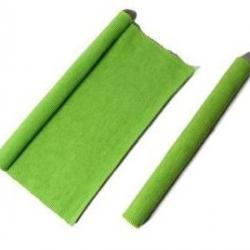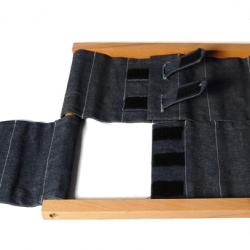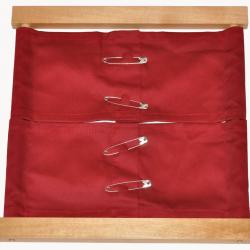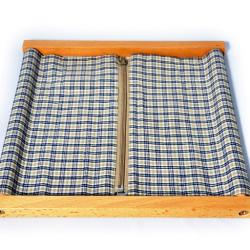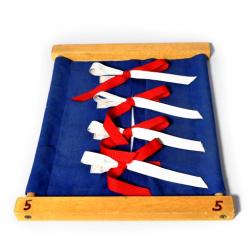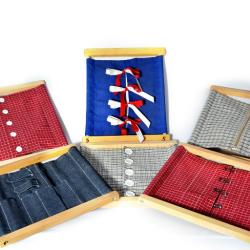To stimulate life, - leaving it then free to develop, to unfold, - herein lies the first task to the educator. In such a delicate task, a great art must suggest the moment, and limit the intervention, in order that we shall arouse no perturbation, cause no deviation, but rather that we shall help the soul which is coming into the fulness of life, and and which shall live from its own forces. This art must accompany the scientific method.
Dr. Maria Montessori The Montessori Method
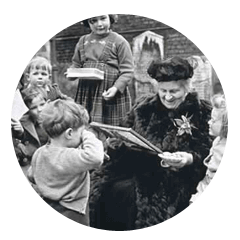
Practical Life Education in Montessori
Practical life in Montessori education curriculum is the first set of lessons taught and introduced in the classroom. The basic idea is to teach orderly arrangement of exercises involving familiar objects and the activities of day-to-day life. Practical life exercises promote mind and body coordination, control and refinement of basic movements. They help in developing better focus on things and helps to achieve maximum concentration on any activity. Practical life exercises in movement, self-help, care of the environment, grace and courtesy capture the preschool children's natural interest and the inborn desire to participate in the affairs of the world around them. These exercises are transformed into purposeful activities which build good habits for exploration and learning which extends to home, learning environment and society.
The practical life exercises are designed to encourage independence and assist in the development of concentration and inner discipline. All materials used are real and more often breakable. The idea is to allow children to build in control of error as it puts them in contact with their realities of environment and teaches responsibility. The exercises are ordered and graded with earlier exercises providing skills needed for advanced ones. The orderliness of the area helps children feel secure and orient themselves in classrooms and develop the order for clear and rational thought. The grading in the exercises ensures that children frequently experience success before attempting new exercises and it fosters self-confidence and self-esteem which are necessary qualities for a fulfilled and successful living.
The teachers introduce children to the full cycle of activities and help them to develop mental and muscular control necessary to succeed in other areas which could be classroom or sports, academics or the wider social environment. All activities in the practical life exercises are purposeful and engaging for both- mind and the hand. It allows them to work together and it is necessary for integrated development of a child's intellect. Children's hands are usually busy with something they are holding or playing with, what's important is that their minds are focused too as it helps in concentration development and spontaneity with repetition. As the children develop increasing control over their movements, it helps them to come under the conscious direction of their will which aides the development of their eagerness and in turn leads them to be more independent in regular day-to-day activities.
Purpose of Practical Life in Montessori
Practical life's main aim is to help children gain control in the coordination of their movements. Also provide them measures to gain independence and an ability to adapt to their society. Practical life exercises aid the growth and development of a child's intellect and concentration and eventually helps the child in developing an orderly way of thinking which is in logical, rational, moral and ethical manner. Montessori's practical life exercises has some basic goals. The activities conducted in the classroom provide real life experiences for children. Practical life exercises are divided into areas such as, care for another person, care for the environment and grace & courtesy. Children are naturally interested in activities they witness everyday, and Dr. Montessori began using practical life exercises to allow children to do activities of daily life to adapt and orient themselves in their society in the manner which they should.
Children are most sensitive to learning till the age six as they are constructing the inner building blocks of themselves, that is the reason it is extremely important for a child to participate in activities to prepare for their environment. They develop a sense of familiarity as the activities progress with age and difficulty and complexity. It is the duty of teachers to demonstrate the correct way of doing the exercises in a way that allows the child to completely observe and follow those movements. The teachers must keep in mind that the goal is to show actions so that children repeat the activities in their own way that might be successful but when not, they can practice and keep themselves busy in repetition and perfecting. When the child has learned those activities, it prepares him/ her for their environment which will allow to grow independently and also use their motor skills. Dr. Montessori said that the teacher's task is to show how the action is done and at the same time destroy the possibility of imitation.
Exercising Practical Life in Montessori
The child must develop his own way of doing these activities so that the movements become real and not synthetic. Dr. Montessori saw the children's need for order, repetition and succession in movements. Practical life exercises helps in a tremendous way in aiding coordination and movement, balance and gracefulness in the child's environment. In addition, practical life exercises teach the children to analyze difficulties they may face and to solve the problems successfully in order to regain their confidence and increase their intellect. Practical life exercises are divided into several areas, initially being the preliminary exercises and elementary movements in which the child is allowed to practice the movements and skills necessary for regular activities. Activities such as buttoning, zipping, snapping, tying, brushing, hand washing and several others teach them to completely finish tasks efficiently and independently.
Practical life exercises are meant to advance children's movements and skills gradually as well as to ensure their awareness of safety while performing those activities. For instance, when children are carrying scissors for art & craft purposes, they are taught how to handle, how to utilize and how to safely maintain them. Rolling a mat, folding the chair, organizing the desk, correcting movements, making the bed, keeping hygiene, maintaining cleanliness and various other activities instill a sense of responsibility that helps children in many ways. Under the are of caring for the environment, exercises such as sweeping, cloth folding, dish washing, pouring and spooning offer great and important lessons to be more nature friendly as they grow. Exercises in grace and courtesy include walking, sitting with right posture, greeting others, manners and communication skills are honed in order to pursue higher quality upbringing. Most children are passionately interested in practical life activities as the activities respond to all the sensitive periods of growth. Teachers build a foundation and structure so that when children grow up, they carry over to other areas of life and lead with successful experiences.

